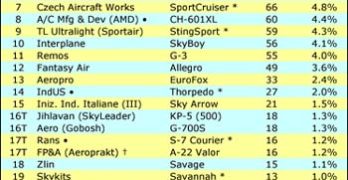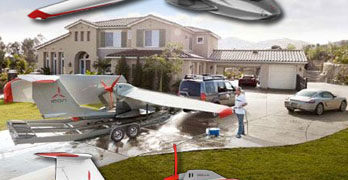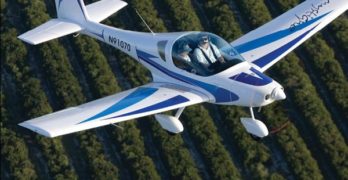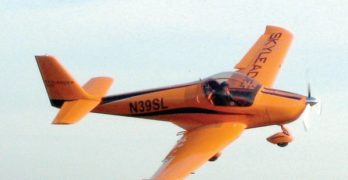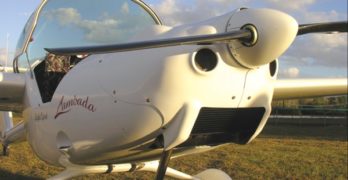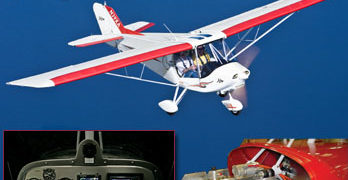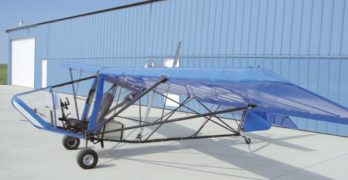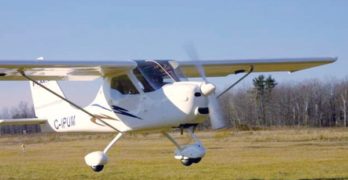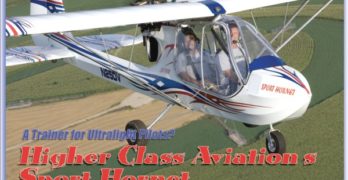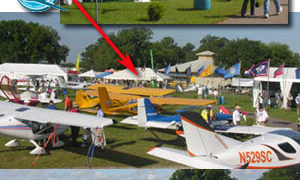Through the first six months of 2008, Light-Sport Aircraft deliveries have reflected the same challenges afflicting the rest of general or sport aviation…and for that matter, the overall U.S. economy. In fact, LSA registrations aren’t off as badly as are GA deliveries, perhaps due to significantly better fuel economy in an LSA. These FAA registrations can be analyzed to show trends. *** In the first half of 2008, the LSA industry registered 248 aircraft, which is 22% of all registrations from April 2005 through December 2007 (1,118). Many find it interesting to observe how market leaders compare. If a supplier registered less than 22% of their fleet in 2008, they slipped in market share (even if they registered more total airplanes). If they exceeded that figure, they gained market share. In the first half of 2008 gainers included: Remos up 62%; Czech Aircraft Works 47%; FPNA 45%; Gobosh 38%; Tecnam 35%; Aeropro 32%; and AMD 28%.
Search Results for : flight design ct
Not finding exactly what you expected? Try our advanced search option.
Select a manufacturer to go straight to all our content about that manufacturer.
Select an aircraft model to go straight to all our content about that model.
Finding New Pilots; Icon Takes a Novel Approach
Most aviation participants have been wringing their hands over the declining pilot population. FAA’s database of active pilots has dropped from 825,000 when I began flying to less than 600,000 today…all while the U.S. population has grown by 50 million. We are clearly doing something wrong, and have for too long had a too-inward focus. *** We have some worthy efforts of outreach. EAA has their fine Young Eagles program. AOPA has its Project Pilot. Companies like Cirrus rove from show to event with their mobile display. Yet we need to do much more. *** L.A.-based Icon Aircraft is one such company that is doing so, recently introducing their new Icon A5 LSA. While the company is presently focused on providing a fascinating new aircraft, they’re looking beyond the existing pilot market. According to their CEO Kirk Hawkins, “Icon’s mission is to bring the freedom, fun, and adventure of flying to the thousands of others who have always dreamed of it.
A Sleek Mystique
But this airplane offers no mystery …
Most pilots will find
nothing mysterious
about the Mystique. In
fact, many readers already
know its manufacturer,
Interplane Aircraft, which
also manufactures the
Skyboy that achieved early
success before light-sport
aircraft (LSA) were given
official status.
Yet to American pilot
eyes, the Mystique is a
new bird on the horizon.
It earned its special lightsport
aircraft (S-LSA)
airworthiness certificate
shortly before the U.S.
Sport Aviation Expo in
mid-January 2007. This is
the second S-LSA approval
for Interplane; Skyboy won
approval in October 2006.
Let’s Meet the Distributor and Manufacturer
Many LSA pilots have come to
know Doug and Betty Hempstead,
the proprietors of several aviation
companies based at the Sanford-Lee
County Regional Airport in North
Carolina. Doug and Betty operate a
flight school, two import enterprises,
and plan to embark on final assembly
of airplanes in the United States.
The Hempsteads import the Allegro,
manufactured in the Czech
Republic by Fantasy Air, under the
Fantasy Air USA name.
SkyLeader’s Wide-Body LSA
Update Note (2021) — This article published in 2008. The aircraft was then referred to as Skyleader 500. Later this was further upgraded and became the Skyleader 600. Obviously, some information presented below will be dated but much of the flight qualities reporting is still useful. —DJ
Sky Leading KP-5
First, Americans became aware of Kappa. This corporate identity was more easily pronounced than the next company name,
Jihlavan (roughly, “YEE-lah-von”) Airplanes. Now, after new investment and with new global ambitions, the company will be known a “Skyleader Aircraft.” American tongues can relax with this easy reference.
Unchanged are a common owner and the same skilled Jihlavan Airplanes
technicians building the elegant KP-5/Skyleader 500 from the Czech
Republic. It may not be the biggest seller among light sport aircraft (LSA),
but I find it to be one of the finest flying machines in the fleet. Skyleader
plans to standardize the brand around the world and will rename the KP-5
the Skyleader 500.
Lambada’s Choice
Motor Along Economically
Not all light sport aircraft (LSA) are made alike.
You probably knew that already, but consider
the Lambada. This sleek composite 2-seat
shoulder wing is part airplane, part glider and it has
the interchangeable wing tips to prove it.
For a soaring enthusiast like myself, flying the
Lambada gratified a desire I’ve had for years, since I
first saw the Urban Air design at a German airshow. On
January 9, 2008, I went aloft in a Lambada with Josef
Bostik – a former U.S. National Champion hang glider
pilot turned airline captain – at Wallaby Ranch, an
iconic hang glider park in Central Florida where hang
gliders are towed aloft behind specially built ultralights.
The particular Lambada I flew bore N-number
N109UA. Bostik indicated that 108 other Lambada
aircraft are flying around the world, though the
one I flew is the first ’08 model to pass ASTM standard
certification.
X-Air Captures SLSA (#78); A Low-Price Leader
Many pilots have complained about the high prices of Light-Sport Aircraft. Customers expected figures like $50,000 or $60,000 (and we had choices at that price in 2003). Now, double or more is common. Read why. But not always. X-Air LS comes in at a surprisingly modest $46,900. Yes, it has sewn Dacron wings (though that helps keep it lighter; no painting). No, it isn’t as sleek as the carbon fiber jobs. Others can fly a bit faster (cruise is 90 mph). Yet for $20,000 less than we thought they should be five years ago — and about one-third the cost of many LSA today — X-Air LS will find some buyers. Indeed, X-Air had a good start at the Flying magazine Parade of Pistons, selling a LSA to the high and fast crowd. X-Air comes standard with the 85-hp Jabiru 2200, giving it spirited performance at very low fuel usage.
T-Bird I and the Future
An Easy-Flying Ultralight
Let’s see. A single-seat plane that can be purchased as an ultralight,
assuming your engine selection doesn’t push it over Part
103’s weight limit, or built from a kit and registered as an
Experimental-class aircraft, or purchased as a light sport aircraft
once the manufacturer meets the ASTM certification. What’s a pilot to do?
That’s the conundrum facing T-Bird I shoppers. This single-seater can be
a Part 103-compliant ultralight when using a Rotax 277, still available on
the used-engine market, though no longer supplied from Rotax’s Austrian
factory. Few prospective owners would select this engine, yet a more powerful
engine would push the T-Bird I over the Part 103 weight limit. Does that
leave only the Experimental amateur-built kit
option?
The answer is no, and yes. To explain this apparent
contradiction, a kit-built T-Bird I with a larger
Rotax engine or the 60-hp HKS 700E engine could
still qualify under the 51% rule.
Flying the Puma
One of Canada’s best-kept secrets can be found hidden
away in a northeastern Ontario town called Hawkesbury. That
secret is the PUMA – a little plane being imported into Canada by
Humberto Dramisino of Otreb Technologies.
When you look into the history of ultralight and light sport aviation,
it’s interesting to note that the successful manufacturers are the ones
that introduce a design and then adjust it as times goes by to better fit
the ever-changing aviation marketplace.
This is what has lead to the success of the PUMA. Designed in Italy
by Antonio Bortolanza, the aircraft has undergone a number of design
transitions since it was first introduced in ’85. Dramisino has been
involved with the manufacture of the PUMA from a very early age. He
first started working in the factory when he was only 15 years of age,
“working just for the pleasure of working on airplanes,” he says.
NH:Higher Class Aviation’s Sport Hornet
At the close of business on January 31,
2008, 2-seat ultralight trainers and overweight
single-seater “ultralights” – as
readers of this publication understand these aircraft
– will cease to exist. More correctly, they
must have been converted to Experimental-Light
Sport Aircraft (ELSA) if their owners want to continue
flying them; otherwise these pilots’ options
are sharply limited.
But as Part 103-compliant ultralights continue
and if ultralight trainers go away, how will new
ultralight pilots be trained for flight in these
lightest of aircraft?
Happily, the subject of this month’s flight
review answers that question. Arguably the first
fixed-wing ultralight to make the jump – not to
ELSA conversion status but to full, Special-LSA
(SLSA) approval – is Higher Class Aviation’s
Sport Hornet.
Gaining Higher Class
We first saw the Hornet when Jim Millett
brought this new design to Sun ‘n Fun ’94 (the
event’s 20th anniversary). It was a bold move into
a market looking well established.
Big Crowds at the Sun ‘n Fun LSA Mall
Sun ‘n Fun 2008 is history, but planning is already underway for the 2009 event. Event boss John Burton confirmed we will again have the LAMA-hosted LSA Mall right at the front gate next April 21-26. A major success at this year’s Lakeland, Florida airshow, the industry Mall presentation featured 17 Special Light-Sport Aircraft. Weather prevented Fantasy Air’s Allegro from attending. Two days before the event, a tornado crushed a Sting S3 planned for display. And work at Quicksilver Manufacturing postponed the exhibit of the GT500 (they’re finishing SLSA approval, reports national sales manager, Todd Ellefson). *** The 17 who were in the ’08 LSA Mall enjoyed significant traffic all week and virtually every visitor to Sun ‘n Fun was at least exposed to Light-Sport Aircraft in a wide variety (although we were not able to enlist any trike or powered parachute companies).
- « Previous Page
- 1
- …
- 116
- 117
- 118
- 119
- 120
- …
- 145
- Next Page »


